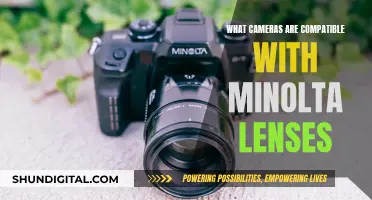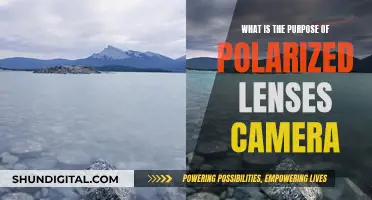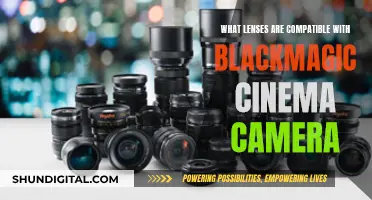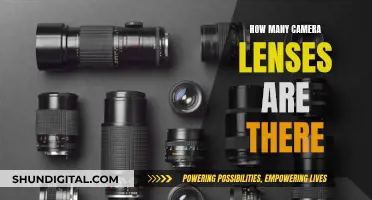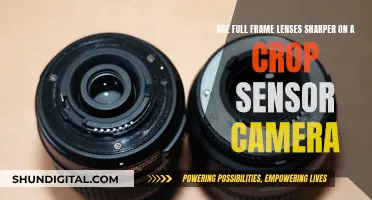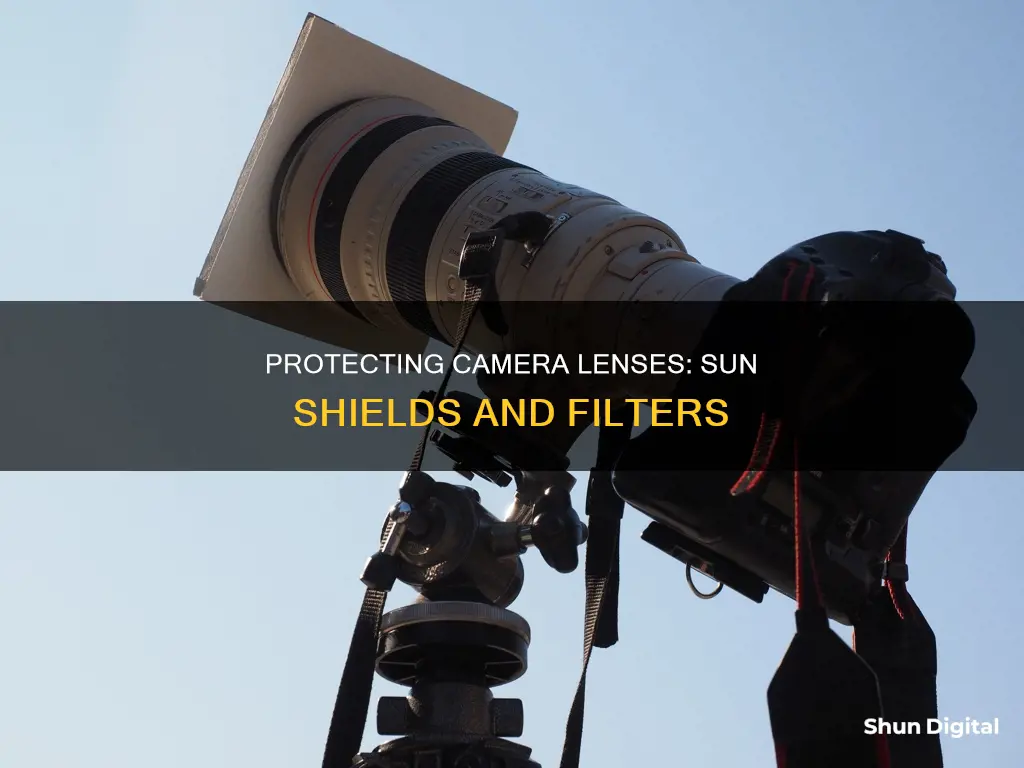
Sun damage to camera lenses is a common issue for photographers, and it can ruin photos with flare and lens distortion. The sun's ultraviolet (UV) rays can cause lenses to degrade over time, leading to discolouration and cracking. This process is known as photochemical degradation.
To protect your camera lens from sun damage, you can use a lens hood, lens cap, or UV filter. These accessories shield your lens from the sun's harmful rays and reduce lens flare and glare. When taking photos in direct sunlight, it is also recommended to use a camera bag, towels or blankets to cover your equipment, and umbrellas to provide shade. Additionally, positioning yourself so that the sun is behind you can help prevent lens flare.
It is important to note that pointing your camera directly at the sun can damage the sensor, as the lens acts as a magnifying glass and intensifies the sun's rays. This can cause permanent damage to the sensor and other internal components. Therefore, it is recommended to avoid pointing your camera at the sun for prolonged periods and to use protective measures when shooting in harsh sunlight.
| Characteristics | Values |
|---|---|
| Camera bag | Keep the camera in a bag when not in use to protect it from the sun and heat |
| Towels | Wrap the camera in a towel or blanket to shield it from the sun's rays |
| Umbrellas | Invest in a couple of umbrellas to provide shade for the camera |
| Internal heating | Use an external battery or a faster memory card to reduce internal heating |
| Lens hood | Use a lens hood to block excess sunlight and reduce glare and flare |
| Solar filter | Use a solar filter to protect the lens from damage when shooting the sun |
| Tripod | Use a tripod for stability when using a solar filter |
| Live View | Use Live View and the LCD screen instead of looking through the viewfinder |
What You'll Learn

Use a lens hood
Using a lens hood is a great way to protect your camera lens from the sun. A lens hood is a plastic or metal accessory that attaches to the front of your lens, shielding it from unwanted light and reducing the amount of lens flare and glare in your photos. It acts as a visor for your lens, blocking out the sun's harmful rays and preventing overheating.
Lens hoods come in different shapes and sizes, with the most common being cylindrical and petal or tulip-shaped. Cylindrical lens hoods are longer and usually accompany prime or telephoto lenses, while petal-shaped hoods are shorter and curved, designed for wide-angle lenses. They can be made from different materials such as plastic, metal, or rubber, and can be attached by screwing them onto the front of your lens.
Lens hoods not only protect your lens from the sun but also offer additional benefits. They can increase image contrast and clarity by reducing the amount of stray light entering the lens. Additionally, they provide an extra layer of protection for your lens, shielding it from accidental impacts, scratches, fingerprints, and weather conditions like rain, snow, or dust.
When choosing a lens hood, it is important to select one that is specifically designed for your lens. The hood should fit securely onto your lens, and you should verify the lens thread size before purchasing. Some lens hoods can also be collapsed or mounted in reverse to save space when not in use.
Lens hoods are a valuable tool for photographers, providing protection and improving image quality. They are easy to use and can make a significant difference when shooting outdoors or in bright conditions. By using a lens hood, you can shield your lens from the sun's rays and capture clear, high-quality images.
Easy Guide to Editing Photos with Round Camera Lenses
You may want to see also

Keep your camera in a bag
Keeping your camera in a bag is a great way to protect it from the sun's harmful rays and extreme temperatures. Here are some tips to keep in mind:
- Use a camera bag: Invest in a dedicated camera bag to protect your equipment from the sun. This will shield your camera from direct sunlight and give it a chance to recover from the heat.
- Padded bags: Opt for a padded bag or insert to provide extra protection for your camera and lenses. This will help safeguard them from bumps and scratches during transport.
- Inner bags: For multi-day trips, consider using smaller, padded inner bags to compartmentalize your gear. This maximizes storage space and distributes weight evenly in your backpack.
- Towels: If you don't have a camera bag, wrap your camera in a towel, blanket, or even clothes to shield it from the sun. This will also help protect your equipment from dust and sand.
- Coolers: If you need to leave your camera in a hot car for a short time, place it inside a cooler with a white towel draped over it. Avoid using ice, as this can cause condensation and potential water damage.
- Battery care: Keep your camera batteries warm by storing them in an inside jacket pocket or wrapping them in a chemical hand warmer. Cold temperatures can drain battery life quickly, so it's essential to keep them insulated.
- Condensation: When moving between air-conditioned spaces and hot outdoor environments, give your camera time to acclimate to prevent condensation buildup. This can be done by leaving it in your camera bag, which will help to gradually adjust to the new temperature.
- Desiccants: Use desiccants, such as silica gel packets, to absorb moisture and protect your gear from mould and fungal growth. This is especially important in humid or coastal climates.
- Heat dissipation: Avoid covering your camera bag in dark or absorbent materials that can trap heat. Instead, opt for light-coloured and reflective fabrics to help dissipate heat and keep your equipment cool.
- Storage: Always store your camera and lenses in a cool, dry place when not in use. Prolonged exposure to direct sunlight or extreme temperatures can damage sensitive components.
Lens Compatibility: Using Old Olympus Lenses on New Cameras
You may want to see also

Cover your camera with a towel
Covering your camera with a towel is a great way to protect it from the sun's harmful rays. Here are some tips to effectively use this method:
Firstly, it is important to use a light-coloured towel, preferably white. Dark colours, especially black, absorb more heat and can make your camera hotter. A white towel will reflect the sunlight and keep your camera cooler. If you don't have a white towel, any light colour will do, but avoid black or other dark shades.
When covering your camera, drape the towel over the camera body and lens. Secure the towel around the lens with a rubber band to ensure it stays in place. You can also drape the rest of the towel over the back of the camera, providing easy access to your controls. This method will help insulate your camera and protect it from direct sunlight.
If you are shooting in extremely hot conditions, it is essential to give your camera breaks. Place it in a gear bag or cooler (without ice) and drape a white towel over it. This will provide shade and help regulate the temperature. You can also use a car with the windows up and a white towel draped over the camera to protect it from the sun. Remember to never leave your camera unattended in a hot car for prolonged periods, as the internal temperature can rise quickly and damage your equipment.
Additionally, when shooting in the sun, consider wearing white or light-coloured clothing to reflect heat away from your body. This will help keep you cool and make your photography experience more comfortable.
By following these tips, you can effectively use a towel to protect your camera from the sun's rays and prevent overheating or damage to your equipment.
Camera Lenses Lifespan: How Long Can You Expect Them to Last?
You may want to see also

Use a solar filter
Solar filters are a great way to protect your camera lenses from the sun. They are designed to block out the sun's harmful rays and reduce the sun's brightness and heat. They are especially useful when photographing the sun, as they allow you to do so safely without damaging your equipment.
When choosing a solar filter, opt for one that is made of a dark material to effectively reduce light transmission. Ensure that the filter is the correct size for your lens and that it is attached securely to the front of your lens. It should be tight enough that it won't fall off if bumped but not too tight that it can't be easily removed. If you're using a telephoto lens, avoid screw-on filters, as they can be challenging to remove and replace quickly.
It is important to only use solar filters that are certified by the manufacturer as safe for use with your specific camera model. This ensures that the filter will not cause damage to your camera or its circuitry. Additionally, be cautious not to look through the viewfinder when using a solar filter, as it may harm your eyes. Instead, use Live View and the LCD screen to compose your image.
Solar filters come in various materials, such as metal on glass, aluminized polyester film, and black polymer. Some filters render the sun white, while others give it a yellow, orange, or bluish tint. Choose the type that best suits your preferences and budget, keeping in mind that all types are effective in protecting your camera equipment from the sun's rays.
By using a solar filter, you can safely capture images of the sun without risking damage to your camera sensor, circuitry, or internal components. It is an essential accessory for any photographer looking to include the sun in their compositions.
Samsung Galaxy S10: The Power of Triple Camera Lens
You may want to see also

Avoid direct sunlight
Direct sunlight can be challenging to work with in photography, but with a few simple techniques, you can easily navigate this issue. Here are some tips to avoid direct sunlight and the problems it brings, such as high contrast, harsh shadows, lens flare, and washed-out images.
- Create Your Own Shade: If you can't move your subject to a shaded area, create shade by using an umbrella, a large piece of cardboard, or any object that casts a shadow and blocks the intense sunlight.
- Change Your Position: Move yourself and your camera to change the angle of the light on your subject. This can help you find a better perspective and reduce the impact of direct sunlight.
- Wait for Better Light: If possible, wait for the sun to go down, or for clouds to cover the sun. The light during sunrise and sunset is softer and more flattering, reducing the harsh effects of direct sunlight.
- Use a Reflector: If fill flash is not an option or not sufficient, use a reflector to bounce light onto your subject and reduce the impact of strong shadows.
- Use a Lens Hood: Many cameras come with a lens hood to cut down on lens flare. If yours doesn't, you can create one with cardboard and duct tape, or even use your hand to shield the lens!
By following these tips, you can avoid the challenges of direct sunlight and capture better photographs.
The Evolution of Point-and-Shoot Cameras: Multiple Lenses, Many Possibilities
You may want to see also
Frequently asked questions
Yes, the sun can damage your camera lens and the camera itself. The sun's UV rays can cause the lens to degrade over time, making it turn yellow, brittle, and cracked.
There are a few ways to protect your camera lens from the sun. You can use a lens hood, lens cap, or UV filter to shield your lens from the sun's harmful rays. You can also try to keep the sun from shining directly into the lens and avoid leaving your camera in a hot car or in direct sunlight for extended periods.
A lens hood is an accessory that attaches to the front of your lens and shields it from stray light, including the sun's rays. It helps to reduce lens flare and glare, and boosts the blacks in your pictures.
In addition to using a lens hood, you can keep your camera in a camera bag, wrap it in a towel or blanket, or set up some umbrellas to provide shade when shooting outdoors. You should also avoid pointing your camera directly at the sun for prolonged periods and be careful when using live view or video mode.


